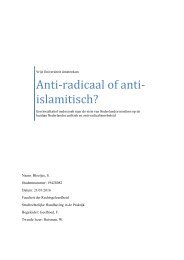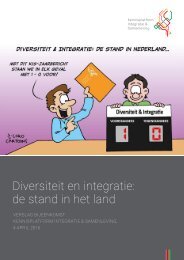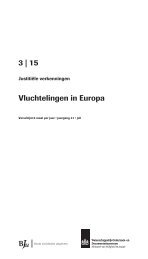fra-2014-being-trans-eu-comparative_en
fra-2014-being-trans-eu-comparative_en
fra-2014-being-trans-eu-comparative_en
You also want an ePaper? Increase the reach of your titles
YUMPU automatically turns print PDFs into web optimized ePapers that Google loves.
Being Trans in the EU – Comparative analysis of EU LGBT survey dataFigure 8: Op<strong>en</strong>ness about <strong>being</strong> <strong>trans</strong> at work in the last five years, by id<strong>en</strong>tity group (%)EU <strong>trans</strong> average3615 9 1327Trans wom<strong>en</strong>3117 14344Trans m<strong>en</strong>402419 15 2Female cross dressers4921 7 6 16Male cross dressers4418 6 9 24Transg<strong>en</strong>der5019 13 15 3G<strong>en</strong>der variant7014 4 5 7Queer/other 20 11 6 658NeverRarelyOft<strong>en</strong>AlwaysDoes not applyto me0 10 20 30 40 50 60 70 80 90 100Question: C8A. During your employm<strong>en</strong>t in the last 5 years, have you …. - A. Be<strong>en</strong> op<strong>en</strong> about you <strong>being</strong> <strong>trans</strong>g<strong>en</strong>der at work?Base: Trans respond<strong>en</strong>ts in the EU LGBT survey who were employed in the last five years.Source: FRA, EU LGBT survey, 2012well: whether or not respond<strong>en</strong>ts have specificallyhidd<strong>en</strong> or disguised their id<strong>en</strong>tity at work. Of all <strong>trans</strong>respond<strong>en</strong>ts, 46 % indicate that they oft<strong>en</strong> or alwayshide or disguise their <strong>trans</strong> background at work.To facilitate further analysis, replies on <strong>being</strong> op<strong>en</strong> andon hiding or disguising were categorised into threegroups: those who are g<strong>en</strong>erally op<strong>en</strong> about their <strong>trans</strong>id<strong>en</strong>tity at work (always op<strong>en</strong> and never or rarely hiding<strong>being</strong> <strong>trans</strong> at work), those who are g<strong>en</strong>erally closeted(never op<strong>en</strong> about <strong>being</strong> <strong>trans</strong> and oft<strong>en</strong> or always disguising<strong>being</strong> <strong>trans</strong> at work), and the rest, who are op<strong>en</strong>selectively (Figure 9).This analysis shows that only 16 % of all <strong>trans</strong> respond<strong>en</strong>tswho were employed in the five years preceding thesurvey were g<strong>en</strong>erally op<strong>en</strong> at work. Two in five wereselectively op<strong>en</strong> (40 %) or g<strong>en</strong>erally closed (44 %),respectively. Trans wom<strong>en</strong> are the most likely of allid<strong>en</strong>tity groups to be g<strong>en</strong>erally op<strong>en</strong> and the least likelyto be g<strong>en</strong>erally closed. Cross dressers and g<strong>en</strong>der variantrespond<strong>en</strong>ts are the most likely to be g<strong>en</strong>erally closedand the least likely to be g<strong>en</strong>erally op<strong>en</strong>. Although <strong>being</strong>op<strong>en</strong> increases with age, ev<strong>en</strong> in the respond<strong>en</strong>t groupaged 55 and above, only one in three (29 %) is g<strong>en</strong>erallyop<strong>en</strong> about <strong>being</strong> <strong>trans</strong> at work.The more their country of resid<strong>en</strong>ce adopts widespreadpositive measures to promote respect for the humanrights of <strong>trans</strong> persons, the more respond<strong>en</strong>ts t<strong>en</strong>d to beg<strong>en</strong>erally op<strong>en</strong> at work and the less they are g<strong>en</strong>erallyclosed. Wh<strong>en</strong> positive measures are very widespread(based on the view of the survey respond<strong>en</strong>ts), onlyone in five <strong>trans</strong> respond<strong>en</strong>ts stay g<strong>en</strong>erally closed atwork, whereas one in two stay g<strong>en</strong>erally closed at workwh<strong>en</strong> positive measures are very rare (Figure 10).Figure 9: Op<strong>en</strong>ness about <strong>being</strong> <strong>trans</strong> at work, by id<strong>en</strong>tity group (%)EU <strong>trans</strong> average164044Trans wom<strong>en</strong>323830Trans m<strong>en</strong>154738Female cross dressers84844G<strong>en</strong>erally op<strong>en</strong>Male cross dressers103554Selectively op<strong>en</strong>Transg<strong>en</strong>der153946G<strong>en</strong>erally closedG<strong>en</strong>der variant52570Queer/other1449370 10 20 30 40 50 60 70 80 90 100Question: C8A. During your employm<strong>en</strong>t in the last 5 years, have you …. - A. Be<strong>en</strong> op<strong>en</strong> about you <strong>being</strong> <strong>trans</strong>g<strong>en</strong>der at work? -B. Hidd<strong>en</strong> or disguised that you are <strong>trans</strong>g<strong>en</strong>der at work? Response categories: never, rarely, oft<strong>en</strong>, always, does notapply to me – recoded into the categories as in the figure.Base:Trans respond<strong>en</strong>ts in the EU LGBT survey who were employed in the last five years. Those who responded ‘Does not applyto me’ were excluded from this calculation.Source: FRA, EU LGBT survey, 201230









